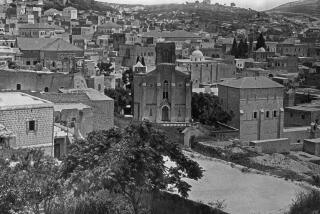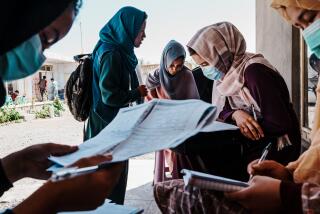In Yemen, tribal tradition trumps education
Reporting from Sana, Yemen — Seventy boys in khaki uniforms cram shoulder to shoulder into chemistry class, where there are no chemicals or test tubes, only the squeak of the teacher’s magic marker drawing diagrams and equations in the minutes before recess.
If there is a genius among the rows of teenage faces, his gift may never be known. The boys are poor and many are undernourished, leaving class every afternoon to sell water and newspapers in the streets. The teacher earns about $200 a month, not enough to support his family, so he looks for odd jobs in the neighborhoods at the city’s edge.
“The teachers are tired and the students are tired. It’s an endless cycle,” says Abu Zaid Kumaim, deputy principal and tribal sheik, who strolls the schoolyard with a rolled newspaper stuffed under his belt, next to his dagger. “I need chairs. I need books. It may take months or one year to get new equipment. Tell me this: Can you live on $200 a month? How can it be done? We have socialist salaries to face lives of capitalist prices.”
The classrooms at the public Hawrash School tell the story of a desperate nation: First-graders with book bags and promise will grow into high school students with few prospects. The education system is overburdened and understaffed. Yemen’s illiteracy rate is nearly 50%, and educators like Kumaim wonder how their country will ever thrive in globalization that prizes ingenuity over the tug of tribe and tradition.
“Students are learning, but their minds don’t change,” says Salah Rashed Alhanshali, a former public school principal. “They graduate with a little knowledge, but they don’t aspire to be scientists. They yearn to be tribal sheiks. It’s the stigma of our history. Teachers are belittled and scrimp by, and students who want to succeed are discouraged by nepotism and corruption.”
The tribal culture “prevails over education,” says Ayub Nagi Barea, a geography teacher who sat with Alhanshali and other teachers on a recent afternoon, sipping sweetened coffee behind courtyard walls. “These kids see that the tribal life gives rewards. ‘A mathematics teacher,’ says the tribe, ‘what is this?’ ”
In the Arab world’s poorest country, where there’s civil war in the north and a secessionist movement in the south, the tribe offers security and respectability. Images of clan leaders are emblazoned on SUVs that whisk through neighborhoods and villages like armed entourages. Even Kumaim, deputy principal for 15 years, had to tend to tribal affairs when his father was ill and he took over as a sheik. He and his two wives have given the tribe 10 children who, he noted without a trace of irony, are enrolled in private, not public, schools.
But it is more than the allure of the tribe that worries the teachers. The men, dressed in tunics and blazers, sat in the courtyard listing problems until dusk, when they broke talk on the fate of Yemen’s education system to answer the call to prayer. They all moonlight, mostly as teachers and principals in other schools, and one of them said: “Islam tells us to teach. If the pay is not enough, there is spiritual reward from God.”
They complain that blackboards are their only teaching materials; students disappear to work as grave diggers or to pick khat, the narcotic-like plant many Yemenis chew; the rich attend private schools while public schools languish; girls in many villages quit school before they’re teenagers; and boys are ripe for the rhetoric of Islamic extremists, especially in the mountains, where government authority is weak and militants sometimes offer cash after recruiting young men on the Internet or in mosques.
“These kids can be exploited by jihadist groups not because of faith or religious fanaticism, but through money,” says Samir Nasser Hezam, a public school math teacher whose second job is selling medicine. “We know the West worries about the recruitment of extremists. It thinks only of security and anti-terrorism. But what the West should be giving us is education and economic development.”
Just about any statistic on the fate of a child’s future in Yemen is less than inspiring.
The United Nations reports that more than half of “all children show signs of stunting” from malnourishment. Forty-six percent of eligible children attend elementary school, the number of computers in classrooms is among the lowest in developing countries, and 41% of teachers have only a secondary diploma or less. These figures, and the extreme hardship they highlight, are exacerbated by Yemen’s 3% annual population growth -- one of the highest in the world; the average woman will have six children.
The teachers sitting in the twilight don’t know what to do except show up in classrooms each day to begin their lessons. Page by page they go, week by week, some of them despairing, others relying on short sentences of borrowed wisdom.
They say that blame only goes so far in a country that is meager to begin with and where, in some classrooms, 100 pairs of eyes follow chalk marks across the board.
“If we continue like this, the future will be terrible,” says Aref Nagi Almothalaa, a deputy principal. “It pains me every day. I want my nation to excel culturally and economically.”
“Without hope,” says Hezam, “the heart breaks.”
Kumaim prefers biting one-liners. A mercurial man, he moves from the hardened dirt of the schoolyard to classrooms of grimy walls, patting heads and lecturing students along the way, scratching his beard between thoughts. He wedges between the boys in chemistry class and, looking around at the empty desktops and lack of equipment, says, “Education here is mainly theoretical.”
He smiles, but it burns away fast.
“When a student graduates, he’ll find difficulties getting into a university,” he says. “And if he attends university, he probably won’t get a job. Only 5% of university graduates find work. The state is failing not only the students, but all of us.”
The high school boys -- teenage girls attend separate schools -- wait for the noon bell to go home. Kumaim waves to younger girls and boys gathering on the other side of the schoolyard for the afternoon elementary session.
He walks along a courtyard wall painted in bright colors. He steps through a gate and slips into the crowd on the street, disappearing into a car that in a little more than an hour will have him on his parched tribal lands beyond the city.
More to Read
Sign up for Essential California
The most important California stories and recommendations in your inbox every morning.
You may occasionally receive promotional content from the Los Angeles Times.











